Related Research Articles

Citrus is a genus of flowering trees and shrubs in the rue family, Rutaceae. Plants in the genus produce citrus fruits, including important crops such as oranges, lemons, grapefruits, pomelos, and limes. The genus Citrus is native to South Asia, East Asia, Southeast Asia, Melanesia, and Australia. Various citrus species have been used and domesticated by indigenous cultures in these areas since ancient times. From there its cultivation spread into Micronesia and Polynesia by the Austronesian expansion ; and to the Middle East and the Mediterranean via the incense trade route, and onwards to Europe and the Americas.
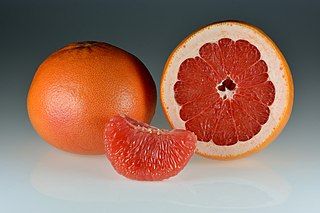
The grapefruit is a subtropical citrus tree known for its relatively large, sour to semi-sweet, somewhat bitter fruit. The interior flesh is segmented and varies in color from pale yellow to dark pink.

A clementine is a tangor, a citrus fruit hybrid between a willowleaf mandarin orange and a sweet orange, named in honor of Clément Rodier, a French missionary who first discovered and propagated the cultivar in Algeria. The exterior is a deep orange colour with a smooth, glossy appearance. Clementines can be separated into 7 to 14 segments. Similar to tangerines, they tend to be easy to peel. They are typically juicy and sweet, with less acid than oranges. Their oils, like other citrus fruits, contain mostly limonene as well as myrcene, linalool, α-pinene and many complex aromatics.

The mandarin orange, also known as the mandarin or mandarine, is a small citrus tree fruit. Treated as a distinct species of orange, it is usually eaten plain or in fruit salads. Tangerines are a group of orange-coloured citrus fruit consisting of hybrids of mandarin orange with some pomelo contribution.
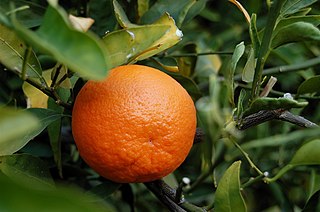
The tangerine is a type of orange. Its scientific name varies. It has been treated as a separate species under the name Citrus tangerina or Citrus x tangerina, or treated as a variety of Citrus reticulata, the mandarine orange. Citrus tangerina is also treated as a synonym of Citrus deliciosa. It is a group of orange-colored citrus fruit consisting of hybrids of mandarin orange varieties, with some pomelo contribution.
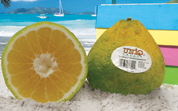
The Jamaican tangelo, also known by proprietary names uglifruit, uglifruit, and uniq fruit, is a citrus fruit that arose on the island of Jamaica through the natural hybridization of a tangerine or orange with a grapefruit, and is thus a tangelo. The original tree is believed to have been a hybrid formed from the Seville orange, the grapefruit and the tangerine families.

The tangelo, Citrus × tangelo, is a citrus fruit hybrid of a Citrus reticulata variety, such as mandarin orange or tangerine, and a Citrus maxima variety, such as a pomelo or grapefruit. The name is a portmanteau of 'tangerine' and 'pomelo'.

The pomelo, or in scientific terms Citrus maxima or Citrus grandis, is the largest citrus fruit from the family Rutaceae and the principal ancestor of the grapefruit. It is a natural, i.e., non-hybrid, citrus fruit, native to Southeast Asia. Similar in taste to a sweet grapefruit, the pomelo is commonly consumed and used for festive occasions throughout Southeast Asia. Like the grapefruit, the pomelo has the potential for drug interactions.

Yuzu is a citrus fruit and plant in the family Rutaceae of East Asian origin. Yuzu has been cultivated mainly in East Asia, though recently also in New Zealand, Australia, Spain, Italy, and France.
An orangelo is a hybrid citrus fruit believed to have originated in Puerto Rico. The fruit, a cross between a grapefruit and an orange, had spontaneously appeared in the shade-providing trees grown on coffee plantations in the Puerto Rican highlands.
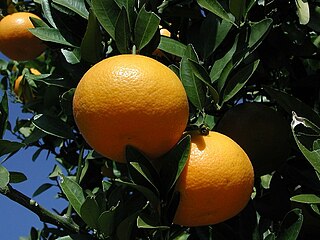
The iyokan, also known as anadomikan (穴門みかん) and Gokaku no Iyokan, is a Japanese citrus fruit, similar in appearance to a mandarin orange, arising from a cross between the Dancy tangerine and another mandarin variety, the kaikoukan. It is the second most widely produced citrus fruit in Japan after the satsuma mandarin.
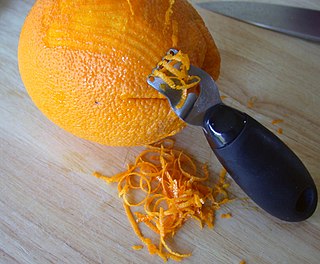
Zest is a food ingredient that is prepared by scraping or cutting from the rind of unwaxed citrus fruits such as lemon, orange, citron, and lime. Zest is used to add flavor to foods.

An orange is a fruit of various citrus species in the family Rutaceae ; it primarily refers to Citrus × sinensis, which is also called sweet orange, to distinguish it from the related Citrus × aurantium, referred to as bitter orange. The sweet orange reproduces asexually ; varieties of sweet orange arise through mutations.

The cam sành or King orange is a citrus hybrid originating in Vietnam.

The lemon is a species of small evergreen trees in the flowering plant family Rutaceae, native to Asia, primarily Northeast India (Assam), Northern Myanmar or China.

The Melogold or Melogold grapefruit is a citrus hybrid similar to the oroblanco; both result from a cross between the pomelo and the grapefruit and is a fruit similar to a sweet grapefruit.

Citrus taxonomy refers to the botanical classification of the species, varieties, cultivars, and graft hybrids within the genus Citrus and related genera, found in cultivation and in the wild.

The New Zealand grapefruit, otherwise known as the Poorman, Poorman orange, poorman's orange, poor man's orange, or goldfruit is a type of citrus fruit grown in New Zealand. Despite its name it's not genetically a true grapefruit, but believed to be a hybrid between a pomelo and either a mandarin or tangelo.
The forbidden fruit is a variety of citrus fruit native to Saint Lucia and once thought to be the origin of the grapefruit.
Kinkoji unshiu is a Citrus hybrid cultivated for its edible fruit.
References
- 1 2 3 4 5 6 7 "Cocktail Grapefruit" . Retrieved 18 January 2017.
- 1 2 3 Durand, Faith (28 January 2009). "Winter citrus Cocktail grape" . Retrieved 18 January 2017.
- 1 2 3 4 5 6 7 8 "Grapefruit Citrus × paradisi". citruspages.free.fr. Retrieved 18 January 2017.
- ↑ "Cocktail pummelo hybrid" . Retrieved 18 January 2017.
- ↑ "Cocktail Grapefruit".
- ↑ Indoor Citrus & Rare Fruit Society Newsletter (Spring 1987)